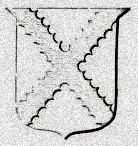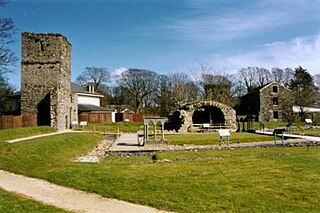Related Research Articles
Thomas de Rossy O. F. M. was a late 14th century Scottish Franciscan friar, papal penitentiary, bishop and theologian. Of unknown, or at least unclear origin, he embarked on a religious career in his early years, entering the Franciscan Order, studying in England and at the University of Paris.
Ingram de Ketenis [de Kethenys] was a medieval cleric from Angus in Scotland.
Oswald O. Cist. was a Cistercian monk and bishop in the late 14th century and early 15th century. There is an Oswald Botelere (Butler) granted a safe-conduct, along with 12 others, to enter England and study at the University of Oxford, in 1365, but this Oswald Butler cannot be shown to be the same as the later Oswald of Glenluce.
Reinald Macer [also called Reginald] was a medieval Cistercian monk and bishop, active in the Kingdom of Scotland during the reign of William the Lion. Originally a monk of Melrose Abbey, he rose to become Bishop of Ross in 1195, and held this position until his death in 1213. He is given the nickname Macer in Roger of Howden's Chronica, a French word that meant "skinny".
Gregoir [Gregory, Gregorius] is the third known 12th century Bishop of Ross, an episcopal see then based at Rosemarkie.
Robert Capellanus, was a chaplain of King William I of Scotland and afterwards, Bishop of Ross (1214–1249).
Roger was a churchman based in the 14th century Kingdom of Scotland, and active as Bishop of Ross from 1325 until 1350. Before attaining this position, Roger was a canon of Abernethy; it is possible that Roger was an Augustinian, because it is often thought that Abernethy did not become a collegiate church until some time after 1328, after the marriage of the Abernethy heiress to the Earl of Angus; this however is not certain, as the exact details of Abernethy's transition from being an Céli Dé abbey to an Augustinian priory to a secular college are only vaguely understood.
Alexander Stewart was a 14th-century Scottish bishop. Probably from Menteith, he appears in the sources from the first half of the 1340s, possessing a university degree and holding the position of Archdeacon of Ross. He was active at the papal curia in the second half of the decade as a papal chaplain and administrator, before being provided as Bishop of Ross in 1350, a position he held until his death in 1371.
Thomas de Dundee, also called Thomas Nicholay, was a Scottish prelate who held the bishopric of Ross during the First War of Scottish Independence. Coming from a family of Dundee burghesses, he was educated as the University of Bologna, before entering into career in the church.
Laurence de Ergadia was a thirteenth-century Scottish bishop. Probably from the MacDougall kindred of Argyll, Laurence had become a Dominican friar and presumably university graduate before being elected Bishop of Argyll, an election which took place sometime between 1262 and 1264. Although the election was quashed by the Pope in 1264, the Pope gave him a fresh provision to the bishopric. Laurence appears intermittently in the records during his three and a half decade episcopate, but his activities in his own diocese are badly recorded. He died as Bishop of Argyll sometime in either 1299 or 1300.

Nicholas O. Tiron, Abbot of Arbroath and Bishop of Dunblane, was a late 13th-century and early 14th-century churchman in the Kingdom of Scotland. Little is known about Nicholas until he appeared on 21 November 1299, holding the position of Abbot of Arbroath in a charter of that abbey; the last attestation of his predecessor Henry can be dated to 16 October 1296, so that Nicholas must have become abbot sometime in between these two dates.
Andrew Magnus was a 14th-century Scottish prelate. Of unknown background, he is recorded for the first time in a document dating to 28 November 1365, holding the position of Archdeacon of Dunblane. Having merely been collated to this position by an ordinary, perhaps the Bishop of Dunblane Walter de Coventre, he received a fresh papal provision on 6 January 1367.
Walter de Coventre was a 14th-century Scottish ecclesiastic. There is no direct evidence of his birthdate, his family, or his family's origin, although he may have come from the region around Abernethy, where a family with the name de Coventre is known to have lived. Walter appeared in the records for the first time in the 1330s, as a student at the University of Paris. From there he went on to the University of Orléans, initially as a student before becoming a lecturer there. He studied the arts, civil law and canon law, and was awarded many university degrees, including two doctorates. His studies were paid for, at least partially, by his benefices in Scotland. Despite holding perhaps more than five benefices at one stage, he did not return to Scotland until the late 1350s.
Bernard was a Tironensian abbot, administrator and bishop active in late 13th- and early 14th-century Scotland, during the First War of Scottish Independence. He first appears in the records already established as Abbot of Kilwinning in 1296, disappearing for a decade before re-emerging as Chancellor of Scotland then Abbot of Arbroath.

William Russell was a fourteenth-century Cistercian prelate. He appears to have begun his career as a Cistercian monk at Rushen Abbey on the Isle of Man (Mann), ascending to the rank of abbot there, before being elected Bishop of Mann and the Isles (Sodor). After traveling to Continental Europe for confirmation and consecration, avoiding a trip to the metropolitan in Norway, he returned to the Irish Sea as a legal bishop. A few things are known of his episcopate, particularly his activities in England and a series of provincial statutes apparently promulgated under his leadership.
John Dongan [Donegan, Donnegan, Donkan, Duncan] was a medieval Manx prelate. After holding the position of Archdeacon of Down, he held three successive bishoprics, Mann and the Isles (Sodor), then the see of Derry and lastly, Down.

William de Crachin was a prelate active in the Kingdom of Scotland in the 13th century. The earliest known Dean of Brechin Cathedral, his first appearance in a surviving source comes 22 September 1248, from a document of Arbroath Abbey.
Nicholas was a Scottish churchman and prelate active at the end of the 13th century. While holding the office of sub-dean of Brechin Cathedral, he got provided bishop of Brechin by Pope Boniface VIII on 21 January 1297.
George Shoreswood or Schoriswood, was a prelate active in the Kingdom of Scotland during the 15th century. He appears to have been of English-speaking origin, from the family of Bedshiel in Berwickshire.
John de Crannach was a 15th-century Scottish scholar, diplomat and prelate. Originating in the north-east of Lowland Scotland, he probably came from a family associated with the burgh of Aberdeen. Like many of his relatives, he flourished in the 15th-century Scottish church. After just over a decade at the University of Paris, Crannach became a servant of the then Dauphin Charles (VII).
References
- Dowden, John (1912), Thomson, John Maitland (ed.), The Bishops of Scotland : Being Notes on the Lives of All the Bishops, under Each of the Sees, Prior to the Reformation, Glasgow: James Maclehose and Sons
- Munch, Peter Andreas; Goss, Alexander, eds. (1988), Chronica regum Manniae et Insularum: The Chronicle of Man and the Sudreys from the Manuscript Codex in the British Museum, with Historical Notes, i (Rev. ed.), Douglas: Manx Society
- Watt, D. E. R.; Murray, A. L., eds. (2003), Fasti Ecclesiae Scoticanae Medii Aevi ad annum 1638, The Scottish Record Society, New Series, Volume 25 (Revised ed.), Edinburgh: The Scottish Record Society, ISBN 0-902054-19-8, ISSN 0143-9448
| Religious titles | ||
|---|---|---|
| Preceded by Bernard | Bishop of the Isles 1331–1348 | Succeeded by William Russell |